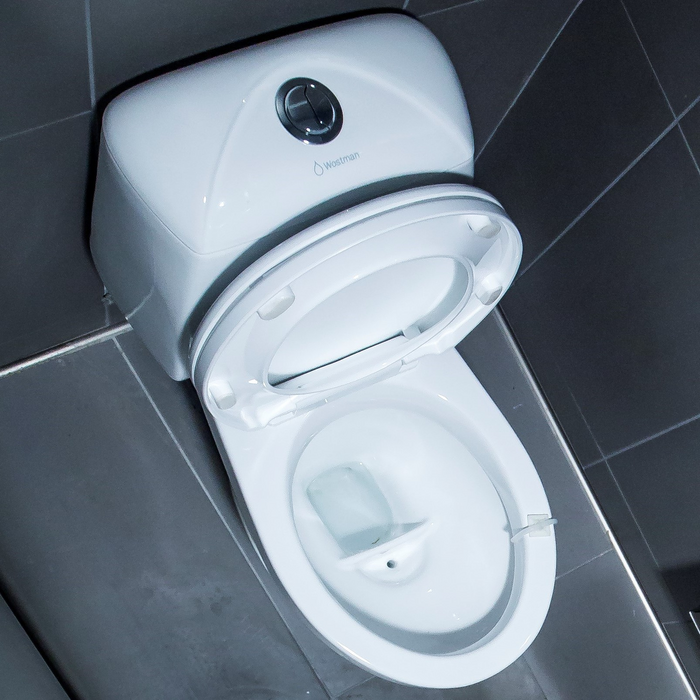Parents often give their children useful advice: Wash your hands, cover your cough and put the toilet lid down before flushing. Now, researchers reporting in ACS ES&T Water address that last bit of wisdom, demonstrating that each flush can spit out thousands of virus particles from infected waste. However, the team says this amount of virus won’t always lead to an infection, and urine-diverting toilets can reduce a person’s exposure compared to traditional systems.

Credit: Adapted from ACS EST Water 2023, DOI: 10.1021/acsestwater.2c00521
Parents often give their children useful advice: Wash your hands, cover your cough and put the toilet lid down before flushing. Now, researchers reporting in ACS ES&T Water address that last bit of wisdom, demonstrating that each flush can spit out thousands of virus particles from infected waste. However, the team says this amount of virus won’t always lead to an infection, and urine-diverting toilets can reduce a person’s exposure compared to traditional systems.
It’s a well-known fact that flushing a toilet sprays out tiny droplets of water, as well as urine and feces, into the air. These particles land on nearby surfaces or get breathed in by people nearby. But if it’s an infected person’s waste that’s flushed, contagious pathogens, such as noroviruses, adenoviruses and human polyomaviruses, could also be ejected into the air. Most commodes in the U.S. are of the traditional mix flush type, and they empty one large water-filled compartment. Another type of toilet is called a urine-diverting system and has two compartments: one that collects urine in the front and another that removes excrement through the back water-filled compartment. Viruses in urine would be removed through the urine-diversion section, but of those that end up in the water, it’s not clear how much get sprayed out. So, Krista Wigginton, Lucinda Li and colleagues wanted to compare the levels of viruses emitted from flushing the two types of systems to estimate their potential for spreading disease.
To simulate the effects of an average excretion event from a sick person, the researchers added solutions with 10 billion surrogate viruses into the water of traditional and urine-diverting toilets in a university restroom. They used two bacteriophages: MS2, which is similar to norovirus, and T3, which stood in for adenovirus and polyomavirus. Then the team simply covered the bowls with plastic film and flushed. Material from the films was recovered and analyzed to see how much MS2 and T3 splashed onto it.
The results showed that less than 1% of the virus surrogates added to the toilets sprayed out. And when protein was added to the water, simulating the proteins found in urine, the traditional commode expelled tens of times more MS2 and T3 than the urine-diverting version. The researchers also calculated the maximum emissions for different viruses from a single flush. For example, they estimated that up to 390 million and 67 million genome copies of norovirus could be emitted from traditional and urine-diverting toilets, respectively. These levels are within the range of an infectious dose; however, the researchers state that it’s unlikely a person would be exposed to all of the particles because some would probably evaporate, settle onto surfaces or be inactivated by handwashing. The next step is to determine a person’s risk of contracting these and other diseases from toilet flushing, the researchers say.
The authors acknowledge funding from a University of Michigan Rackham Merit Fellowship, a University of Michigan MCubed grant and the U.S. National Science Foundation.
The American Chemical Society (ACS) is a nonprofit organization chartered by the U.S. Congress. ACS’ mission is to advance the broader chemistry enterprise and its practitioners for the benefit of Earth and all its people. The Society is a global leader in promoting excellence in science education and providing access to chemistry-related information and research through its multiple research solutions, peer-reviewed journals, scientific conferences, eBooks and weekly news periodical Chemical & Engineering News. ACS journals are among the most cited, most trusted and most read within the scientific literature; however, ACS itself does not conduct chemical research. As a leader in scientific information solutions, its CAS division partners with global innovators to accelerate breakthroughs by curating, connecting and analyzing the world’s scientific knowledge. ACS’ main offices are in Washington, D.C., and Columbus, Ohio.
To automatically receive news releases from the American Chemical Society, contact [email protected].
Follow us: Twitter | Facebook | LinkedIn | Instagram
Journal
ACS ES&T Water
DOI
10.1021/acsestwater.2c00521
Article Title
“Virus Emissions from Toilet Flushing: Comparing Urine-Diverting to Mix Flush Toilets”
Article Publication Date
25-Jan-2023




